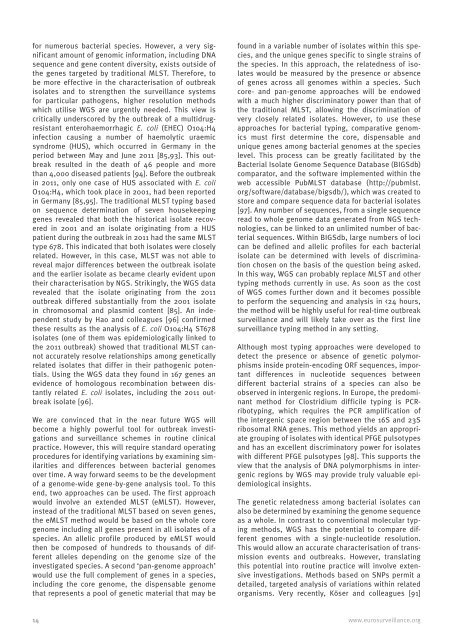Neisseria meningitidis - Eurosurveillance
Neisseria meningitidis - Eurosurveillance
Neisseria meningitidis - Eurosurveillance
Create successful ePaper yourself
Turn your PDF publications into a flip-book with our unique Google optimized e-Paper software.
for numerous bacterial species. However, a very significant<br />
amount of genomic information, including DNA<br />
sequence and gene content diversity, exists outside of<br />
the genes targeted by traditional MLST. Therefore, to<br />
be more effective in the characterisation of outbreak<br />
isolates and to strengthen the surveillance systems<br />
for particular pathogens, higher resolution methods<br />
which utilise WGS are urgently needed. This view is<br />
critically underscored by the outbreak of a multidrugresistant<br />
enterohaemorrhagic E. coli (EHEC) O104:H4<br />
infection causing a number of haemolytic uraemic<br />
syndrome (HUS), which occurred in Germany in the<br />
period between May and June 2011 [85,93]. This outbreak<br />
resulted in the death of 46 people and more<br />
than 4,000 diseased patients [94]. Before the outbreak<br />
in 2011, only one case of HUS associated with E. coli<br />
O104:H4, which took place in 2001, had been reported<br />
in Germany [85,95]. The traditional MLST typing based<br />
on sequence determination of seven housekeeping<br />
genes revealed that both the historical isolate recovered<br />
in 2001 and an isolate originating from a HUS<br />
patient during the outbreak in 2011 had the same MLST<br />
type 678. This indicated that both isolates were closely<br />
related. However, in this case, MLST was not able to<br />
reveal major differences between the outbreak isolate<br />
and the earlier isolate as became clearly evident upon<br />
their characterisation by NGS. Strikingly, the WGS data<br />
revealed that the isolate originating from the 2011<br />
outbreak differed substantially from the 2001 isolate<br />
in chromosomal and plasmid content [85]. An independent<br />
study by Hao and colleagues [96] confirmed<br />
these results as the analysis of E. coli O104:H4 ST678<br />
isolates (one of them was epidemiologically linked to<br />
the 2011 outbreak) showed that traditional MLST cannot<br />
accurately resolve relationships among genetically<br />
related isolates that differ in their pathogenic potentials.<br />
Using the WGS data they found in 167 genes an<br />
evidence of homologous recombination between distantly<br />
related E. coli isolates, including the 2011 outbreak<br />
isolate [96].<br />
We are convinced that in the near future WGS will<br />
become a highly powerful tool for outbreak investigations<br />
and surveillance schemes in routine clinical<br />
practice. However, this will require standard operating<br />
procedures for identifying variations by examining similarities<br />
and differences between bacterial genomes<br />
over time. A way forward seems to be the development<br />
of a genome-wide gene-by-gene analysis tool. To this<br />
end, two approaches can be used. The first approach<br />
would involve an extended MLST (eMLST). However,<br />
instead of the traditional MLST based on seven genes,<br />
the eMLST method would be based on the whole core<br />
genome including all genes present in all isolates of a<br />
species. An allelic profile produced by eMLST would<br />
then be composed of hundreds to thousands of different<br />
alleles depending on the genome size of the<br />
investigated species. A second ‘pan-genome approach’<br />
would use the full complement of genes in a species,<br />
including the core genome, the dispensable genome<br />
that represents a pool of genetic material that may be<br />
found in a variable number of isolates within this species,<br />
and the unique genes specific to single strains of<br />
the species. In this approach, the relatedness of isolates<br />
would be measured by the presence or absence<br />
of genes across all genomes within a species. Such<br />
core- and pan-genome approaches will be endowed<br />
with a much higher discriminatory power than that of<br />
the traditional MLST, allowing the discrimination of<br />
very closely related isolates. However, to use these<br />
approaches for bacterial typing, comparative genomics<br />
must first determine the core, dispensable and<br />
unique genes among bacterial genomes at the species<br />
level. This process can be greatly facilitated by the<br />
Bacterial Isolate Genome Sequence Database (BIGSdb)<br />
comparator, and the software implemented within the<br />
web accessible PubMLST database (http://pubmlst.<br />
org/software/database/bigsdb/), which was created to<br />
store and compare sequence data for bacterial isolates<br />
[97]. Any number of sequences, from a single sequence<br />
read to whole genome data generated from NGS technologies,<br />
can be linked to an unlimited number of bacterial<br />
sequences. Within BIGSdb, large numbers of loci<br />
can be defined and allelic profiles for each bacterial<br />
isolate can be determined with levels of discrimination<br />
chosen on the basis of the question being asked.<br />
In this way, WGS can probably replace MLST and other<br />
typing methods currently in use. As soon as the cost<br />
of WGS comes further down and it becomes possible<br />
to perform the sequencing and analysis in
















